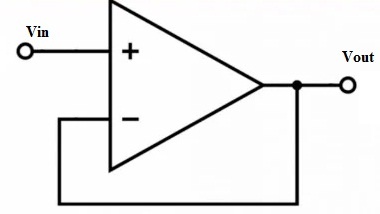Experiment 5: Operational Amplifier working as Voltage Follower
What is a Voltage Follower?
Voltage follower can be defined as when the output of the op-amp circuit follows the input of the op-amp directly. So both the input and output voltages are the same. This circuit doesn’t supply any amplification. As a result, voltage gain is equivalent to 1. It is also known as unity gain, buffer & isolation amplifier. This circuit has high input impedance so it is used in different circuits. The voltage follower uses the input signal to give efficient isolation of output. The basic diagram is shown below.

Voltage Follower Circuit
What is the Purpose of a Voltage Follower?
The main purpose of voltage follower is, it gives the same input voltage as an output voltage. In other words, it has current gain but no voltage gain.
For a better understanding of this concept, the following voltage follower circuit is explained below. Consider the circuit below including a power source and less impedance load. This circuit draws a huge amount of current through the connected load because of the low resistance load. So, the circuit uses a huge amount of power from the source of power and gives high troubles within the source of power.
After that, we can believe that we are providing equal power for the voltage follower. Because, the input impedance of this circuit is high, and less amount of current will be drawn from the above circuit. This circuit output is the same as its input because of the lack of feedback resistors.


